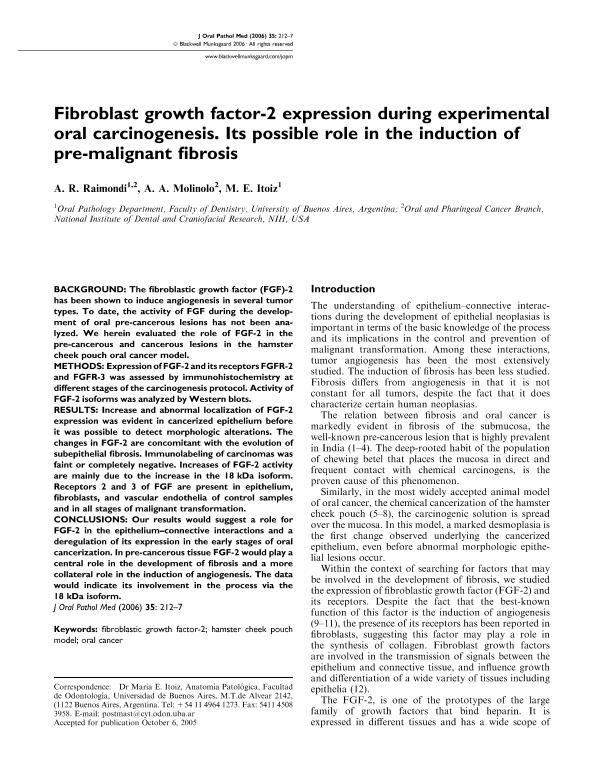Artículo
Fibroblast growth factor-2 expression during experimental oral carcinogenesis. Its possible role in the induction of premalignant fibrosis
Fecha de publicación:
12/2006
Editorial:
Wiley Blackwell Publishing, Inc
Revista:
Journal Of Oral Pathology And Medicine
ISSN:
0904-2512
Idioma:
Inglés
Tipo de recurso:
Artículo publicado
Clasificación temática:
Resumen
BACKGROUND: The fibroblastic growth factor (FGF)-2 has been shown to induce angiogenesis in several tumor types. To date, the activity of FGF during the development of oral pre-cancerous lesions has not been analyzed. We herein evaluated the role of FGF-2 in the pre-cancerous and cancerous lesions in the hamster cheek pouch oral cancer model. METHODS: Expression of FGF-2 and its receptors FGFR-2 and FGFR-3 was assessed by immunohistochemistry at different stages of the carcinogenesis protocol. Activity of FGF-2 isoforms was analyzed by Western blots. RESULTS: Increase and abnormal localization of FGF-2 expression was evident in cancerized epithelium before it was possible to detect morphologic alterations. The changes in FGF-2 are concomitant with the evolution of subepithelial fibrosis. Immunolabeling of carcinomas was faint or completely negative. Increases of FGF-2 activity are mainly due to the increase in the 18 kDa isoform. Receptors 2 and 3 of FGF are present in epithelium, fibroblasts, and vascular endothelia of control samples and in all stages of malignant transformation. CONCLUSIONS: Our results would suggest a role for FGF-2 in the epithelium-connective interactions and a deregulation of its expression in the early stages of oral cancerization. In pre-cancerous tissue FGF-2 would play a central role in the development of fibrosis and a more collateral role in the induction of angiogenesis. The data would indicate its involvement in the process via the 18 kDa isoform.
Archivos asociados
Licencia
Identificadores
Colecciones
Articulos(OCA HOUSSAY)
Articulos de OFICINA DE COORDINACION ADMINISTRATIVA HOUSSAY
Articulos de OFICINA DE COORDINACION ADMINISTRATIVA HOUSSAY
Citación
Raimondi, Ana Rosa; Molinolo, A. A.; Itoiz, Maria Elena; Fibroblast growth factor-2 expression during experimental oral carcinogenesis. Its possible role in the induction of premalignant fibrosis; Wiley Blackwell Publishing, Inc; Journal Of Oral Pathology And Medicine; 35; 4; 12-2006; 212-217
Compartir




